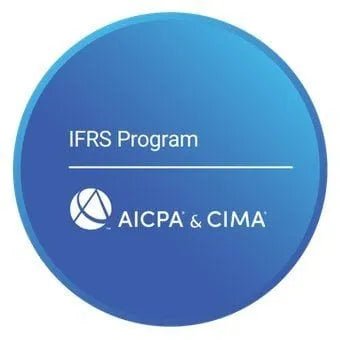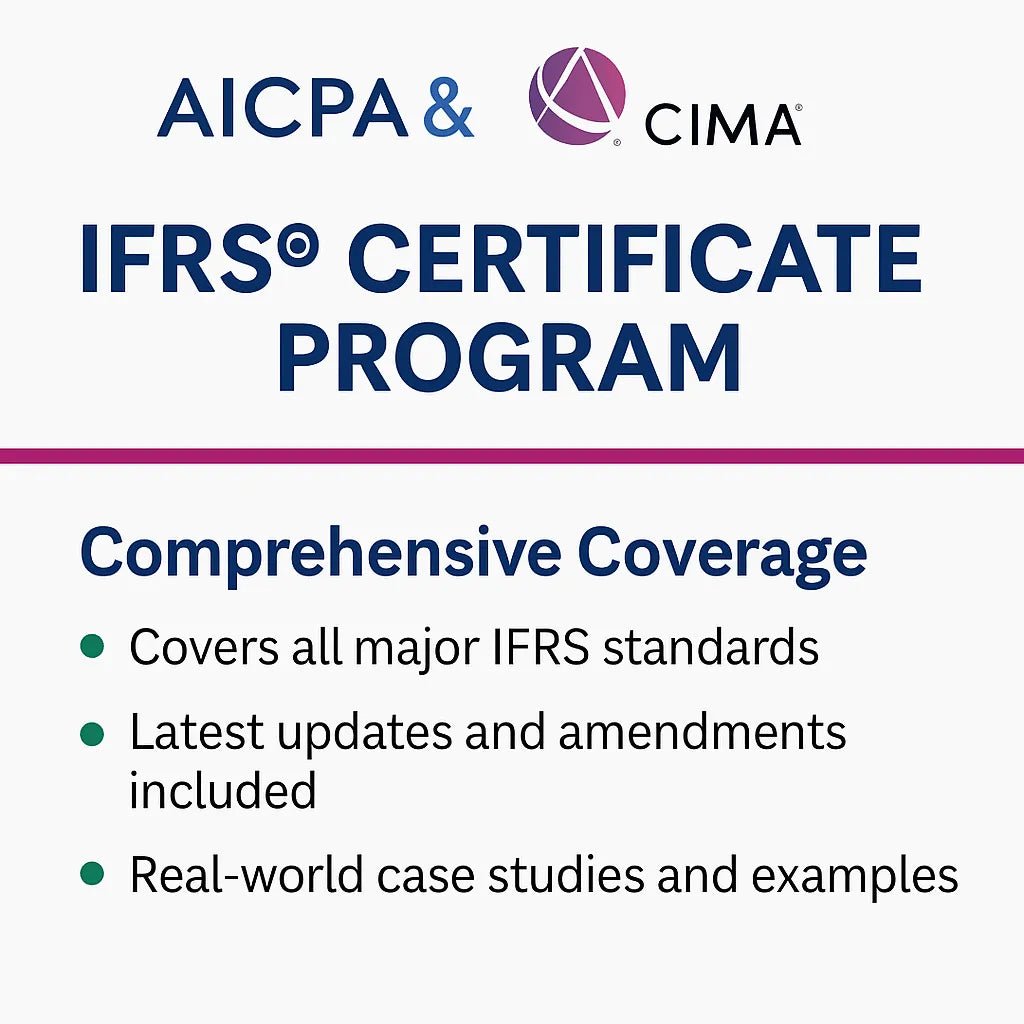IFRS 19 VS full IFRS standards
IFRS 19 vs Full IFRS Standards: Comprehensive Guide to Reduced Disclosure Requirements
IFRS 19 introduces reduced disclosure requirements for subsidiaries without public accountability, allowing them to comply with IFRS without the entire burden of extensive disclosures. This guide examines the differences between IFRS 19 and complete IFRS standards, including the effective dates, early adoption options, and specific disclosure modifications allowed under IFRS 19.
Master IFRS with AICPA Certification—Now 70% Off at Eduyush’s India Pricing
Overview of IFRS 19- Subsidiaries without Public Accountability and Effective Dates
IFRS 19: Subsidiaries without Public Accountability apply to subsidiaries that are not publicly accountable and have a parent company using IFRS standards. Adopting IFRS 19 allows these subsidiaries to meet essential reporting needs without extensive disclosures, reducing compliance time and costs.
Effective Date for IFRS 19
- Mandatory Effective Date: IFRS 19 is effective for annual reporting periods beginning on or after January 1, 2027.
- Early Adoption: Early adoption is permitted, which means subsidiaries can apply IFRS 19 in their financial reporting before the official effective date.
Steps for Early Adoption of Subsidiaries without Public Accountability
Subsidiaries wishing to adopt IFRS 19 early should follow these steps:
- Obtain Approval from the Parent Company: Since IFRS 19 is intended to align with group reporting, it’s essential to consult the parent company and ensure that early adoption aligns with group objectives and reporting timelines.
- Communicate with Auditors: Discuss early adoption with your audit team to verify that all requirements are met and to confirm that reduced disclosures comply with IFRS 19 guidelines.
- Update Financial Reporting Processes: Adjust internal processes to reflect IFRS 19 disclosures. Train financial staff to follow the streamlined reporting requirements, ensuring consistency and compliance with the new standard.
- Document Early Adoption: Clearly state in financial statements that IFRS 19 has been adopted early, and specify the reporting period for transparency to stakeholders and regulatory bodies.
Get the ACCA Diploma in IFRS with FREE £89 Registration + Live Lectures!
Detailed Comparison: IFRS 19 vs Full IFRS Standards
The following sections provide a detailed breakdown of how IFRS 19 changes or omits specific disclosure requirements across major IFRS standards.
IFRS 7: Financial Instruments Disclosures
- Risk Exposure and Management: Subsidiaries disclose general risk exposure information without the detailed risk analysis required by full IFRS.
- Fair Value Measurement: IFRS 19 simplifies fair value disclosures, requiring only essential measurement data.
Full IFRS Requirement: Full IFRS requires comprehensive risk data, including credit, market, and liquidity risk assessments and sensitivity analyses.
IFRS 13: Fair Value Measurement
- Fair Value Hierarchy: Subsidiaries may omit the level-specific disclosures (Level 1, 2, and 3) required by full IFRS.
- Valuation Techniques: Reduced requirements on describing complex valuation methods and inputs.
Complete IFRS Requirement: Detailed disclosures on each fair value level and all unobservable inputs are mandatory.
IAS 16: Property, Plant, and Equipment
- Revaluation and Impairment: Simplifies disclosures to a general summary of carrying values.
- Component Breakdown: Subsidiaries may omit detailed information on asset components.
Complete IFRS Requirement: Comprehensive disclosure on revalued assets, component costs, and impairment factors.
IAS 19: Employee Benefits
- Defined Benefit Plans: Requires only total plan expenses, omitting details like actuarial assumptions and sensitivity analyses.
- Funding Status: Allows subsidiaries to exclude detailed disclosures on plan funding and asset-liability matching.
Complete IFRS Requirement: Full breakdown of actuarial assumptions, plan assets, and sensitivity analysis of critical assumptions.
IAS 24: Related Party Disclosures
- Transaction Details: Summarized disclosures of related party transactions without detailed terms.
- Compensation: Only material compensation information is required for key management.
Complete IFRS Requirement: Detailed breakdown of all related party transactions and total critical management compensation.
IFRS 15: Revenue from Contracts with Customers
- Revenue Disaggregation: Subsidiaries provide only total revenue figures, omitting type or geographic breakdowns.
- Performance Obligations: Only a general description is required.
Full IFRS Requirement: Comprehensive disclosure of revenue by type, geography, and timing, with detailed performance obligation terms.
IFRS 16: Leases
- Lease Maturity Analysis: A simplified lease liability disclosure is allowed, omitting detailed maturity analyses.
- Variable Payments: General disclosure of variable payments without breakdowns by lease.
Full IFRS Requirement: A full breakdown of lease maturity by periods and separate disclosures for fixed and variable payments.
IAS 1: Presentation of Financial Statements
- Capital Management: Subsidiaries provide a summary of capital management policies if material.
- Judgments and Estimates: Only significant judgments impacting financial statements are disclosed.
Full IFRS Requirement: Detailed disclosures on all critical judgments, estimates, and assumptions.
IAS 36: Impairment of Assets
- Impairment Testing: Subsidiaries disclose high-level impairment information without sensitivity analyses.
- Cash-Generating Units: Reduced disclosure on CGU assumptions and calculations.
Complete IFRS Requirement: Comprehensive impairment testing details, including sensitivity and projected cash flow data.
IAS 38: Intangible Assets
- Amortization and Impairment: General disclosures on intangible assets; no detailed impairment schedules.
- Research and Development Costs: Total R&D costs if material; detailed cost breakdowns are omitted.
Complete IFRS Requirement: Specific disclosures for all intangible assets, including amortization, impairment, and R&D activities.
Benefits for Subsidiaries Without Public Accountability
Opting for IFRS 19 offers several critical advantages over complete IFRS standards:
- Cost Reduction: Subsidiaries can save up to 20% in audit and compliance costs due to streamlined disclosures.
- Time Efficiency: Reduced disclosures can cut financial reporting time by 30%, allowing teams to focus on core operations.
- Alignment with Group Reporting: IFRS 19 enables subsidiaries to harmonize with parent company reporting without excessive disclosure.
Steps for Subsidiaries Transitioning to IFRS 19
For subsidiaries choosing IFRS 19, follow these steps to ensure a smooth transition:
- Confirm Eligibility: Verify the subsidiary qualifies as a non-public entity.
- Engage with Parent Company: Coordinate with the parent’s finance team to align IFRS 19 disclosures with group reporting.
- Prepare Reporting Teams: Train teams on IFRS 19 requirements and disclosure reductions to ensure accurate reporting.
- Consider Early Adoption: If opting for early adoption, disclose this choice clearly in the financial statements.
Conclusion on IFRS on Subsidiaries without Public Accountability
IFRS 19 provides a valuable framework for subsidiaries without public accountability to report under IFRS while minimizing disclosure requirements.
Adopting this new standard allows subsidiaries to achieve cost-effective compliance, streamlined reporting, and enhanced alignment with parent companies’ financial statements.
FAQs
ACCA blogs
Follow these links to help you prepare for the ACCA exams
IFRS blogs
Follow these blogs to stay updated on IFRS
Formats
Use these formats for day to day operations
- Account closure format
- Insurance claim letter format
- Transfer certification application format
- Resignation acceptance letter format
- School leaving certificate format
- Letter of experience insurance
- Insurance cancellation letter format
- format for Thank you email after an interview
- application for teaching job
- ACCA PER examples
- Leave application for office
- Marketing manager cover letter
- Nursing job cover letter
- Leave letter to class teacher
- leave letter in hindi for fever
- Leave letter for stomach pain
- Leave application in hindi
- Relieving letter format
Interview questions
Link for blogs for various interview questions with answers
- Strategic interview questions
- Accounts payable interview questions
- IFRS interview questions
- CA Articleship interview questions
- AML and KYC interview questions
- Accounts receivable interview questions
- GST interview questions
- ESG Interview questions
- IFRS 17 interview questions
- Concentric Advisors interview questions
- Questions to ask at the end of an interview
- Business Analyst interview questions
- Interview outfits for women
- Why should we hire you question
leave application format
- Leave application for office
- Leave application for school
- Leave application for sick leave
- Leave application for marriage
- leave application for personal reasons
- Maternity leave application
- Leave application for sister marriage
- Casual leave application
- Leave application for 2 days
- Leave application for urgent work
- Application for sick leave to school
- One day leave application
- Half day leave application
- Leave application for fever
- Privilege leave
- Leave letter to school due to stomach pain
- How to write leave letter
Insurance blogs
- Sample letter of appeal for reconsideration of insurance claims
- How to increase insurance agent productivity
- UAE unemployment insurance
- Insurance cancellation letter
- Insurance claim letter format
- Insured closing letter formats
- ACORD cancellation form
- Provision for insurance claim
- Cricket insurance claim
- Insurance to protect lawsuits for business owners
- Certificate holder insurance
- does homeowners insurance cover mold
- sample letter asking for homeowner right to repair for insurance
- Does homeowners insurance cover roof leaks













Leave a comment